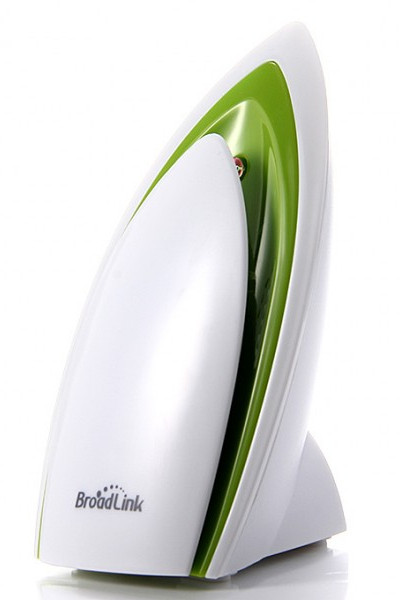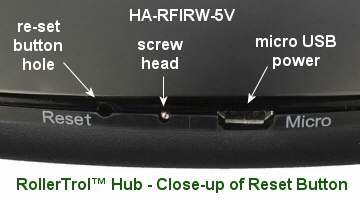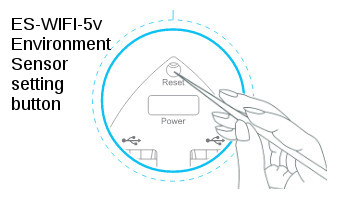Phone App for Blind Motors: Alternate WiFi Setup Using AP Mode

This article is about an alternative method of using AP (access point) mode for the BroadLink® controllers and sensors for operating our blind motors, skylight/window openers, smart film, drapery motors, and many other devices.
It is very unlikely that you will need to use the wifi pairing method described on this page; the SmartConfig™ works almost every time. If you have not yet attempted to assign your devices using the automatic SmartConfig™ system, you can return to the main starting point for this article series about remote control of blinds, shades, and window openers.
The BroadLink® controller system has quickly become our automation system of choice for a number of reasons, not the least being the ease-of-use factor, and if you follow these instructions carefully, you will find that it is quite "user friendly".
One of the most important features is its ability to "learn" RF radio commands, which means it can directly control our blind motors and window/skylight openers, whether they are our G series radio motors and receivers, or the older R series motors. It is also an excellent IR code learner too, for controlling all your media systems, including projector screens and blackout blinds.
The ES-WIFI-5V environmental sensor shown on this page can be used as a trigger to activate a motor (or any other device) when conditions change, such as a temperature/humidity/light level increase or decrease. It has IFTTT (if-this-then-that) capabilities.
Please note: the SK1-WIFI-AC Security Kit does not have this mode, you will have to use the SmartConfig™ method.
You will need to download and install the BroadLink® app on your phone or tablet (Android or Apple IOS) if you want to continue with these instructions. Please refer to the download instructions for the BroadLink software.
When you first open and run the software you have downloaded, the program will detect that you are a first time user and you will very likely be able to use the SmartConfig™ method to simply enter your WiFi ID/password credentials and have it connect automatically. If that works and you get a "successful connection" message, you can skip the AP method described below.
AP MODE: Alternate Device Connection Method for Your WiFi Router
There are two main steps involved in this procedure:
- Connect the phone or tablet app to your device in AP mode
- Tell your device which WiFi network to connect to
These instructions show how to connect the ES-WIFI-5V environmental sensor and the HA-RFIRW-5V remote control hub to your wifi router using the alternate AP mode (if your SmartConfig™ failed). The SP-WIFI-AC smart plug also uses the same procedure for configuring the wifi connection; all these devices have the same re-set button and flashing LED indicator, but they are in different places.
Please Note: If you ever need to re-set the unit to the factory default, you would insert a small screwdriver or paper clip into the setting hole and press (and hold) the setting button until you see the rapid flashing pattern. The SP-WIFI-AC smart plug has an accessible finger-press button.


With power applied and the blue LED rapidly flashing, please press and hold the setting button with a small screwdriver or paper clip, until the blue LED flashes slowly. You should be able to feel a tactile "click" when you press the setting button correctly.
This action causes it to enter AP (Access Point) mode, and the LED should display a repeating pattern of 4 slow flashes followed by a one second pause.
The AP mode is actually the same mode that your WiFi router operates with in its normal configuration. In other words, the device becomes a router that you can communicate with, using your phone, tablet or phablet. You should see it in the list of available WiFi connections, listed as Broadlinkprov (it is an unsecured connection, so no password is required).
Don't connect your phone to it yet unless you have downoaded the software; if you disconnect from your router and connect to the device in AP mode, you will stop your outside connection to the internet. Once the process of pairing the device in AP mode is complete, your WiFi system will revert back to normal.
After you select the sensor connection (Broadlinkprov), the app should dispaly another list of available WiFi routers. Please press and select the name of your actual house WiFi network and enter your password (as shown in the picture on right, below). The password of your Wi-Fi network will be saved and you will never need to input the password again when you start up the app, even if you have interrupted the power to the sensor (unless you do a factory reset).


Please Note: Once your device has been paired with your Wi-Fi router, the LED indicator light will blink slowly for a brief period, then it will stay OFF, indicating a good connection (there should also be a screen message in the app, indicating success). If you know how to login to your WiFi router, it will show up on the client list.
After the Device is Successfully Connected to your WiFi Network
The device will also show up on the 'Device List' in the app with an icon representing the device as shown in the middle picture below. It will have a default name, but you can select it and change the name to whatever you want.
At this point, you have successfully completed the WiFi configuration for your device and you can return to the article to complete the setup of your particular device.
Smart Remote Control Hub Article Series:
Smart hub for blind motors: Introduction
Temperature Sensitive Blind Article Series
IFTTT example: temperature and light sensitive blinds and shades
Smart Plug Article
Wi-Fi Smart Plug with timers and IFTTT capabilities
Skylight Rain Senor Article Series
IFTTT example: rain sensor for closing skylights
Buy These Products In Our Online Store
If you are interested, you can purchase these products in our DIY online automation store.

 Shopping Cart Home - Start Here
Shopping Cart Home - Start Here Remote Controls for Radio Equipped Motors
Remote Controls for Radio Equipped Motors DIY Starter Kits for Window Shades
DIY Starter Kits for Window Shades DIY Starter Kits for Window Openers
DIY Starter Kits for Window Openers ZWAVE Blind & Shade Controllers
ZWAVE Blind & Shade Controllers How To Choose the Right Blind & Shade Motor
How To Choose the Right Blind & Shade Motor Select tubular Motor (Comparison table)
Select tubular Motor (Comparison table) Choose RollerTrol Battery & Solar Motors
Choose RollerTrol Battery & Solar Motors DIY Roller Blind Motors - FAQ
DIY Roller Blind Motors - FAQ How To Insert Blind Motors & Attach Brackets
How To Insert Blind Motors & Attach Brackets Calculate your Blind or Shade fabric Weight
Calculate your Blind or Shade fabric Weight Select Tube Size for Blind Motor
Select Tube Size for Blind Motor How to Insert Blind Motors Into Tube
How to Insert Blind Motors Into Tube How to Insert Blind Motors Into Tube with Adapters
How to Insert Blind Motors Into Tube with Adapters Attach Mounting Brackets - Standard + Mini Series
Attach Mounting Brackets - Standard + Mini Series Attach Mounting Brackets - MAXI Blind Series
Attach Mounting Brackets - MAXI Blind Series How To Set Up Radio Equipped Blind & Shade Motors
How To Set Up Radio Equipped Blind & Shade Motors Series P Radio Remote Control Motors
Series P Radio Remote Control Motors Series G Radio Remote Control Motors
Series G Radio Remote Control Motors Series R Radio Remote Control Motors
Series R Radio Remote Control Motors BroadLink RF/IR Hub System for Motors
BroadLink RF/IR Hub System for Motors How To Set Up Window/Skylight Openers
How To Set Up Window/Skylight Openers Introduction: Window & Skylight (K Series)
Introduction: Window & Skylight (K Series) BroadLink RF/IR Hub System for Motors
BroadLink RF/IR Hub System for Motors Z-Wave Interfacing for Shade & Opener Motors
Z-Wave Interfacing for Shade & Opener Motors Wired Wall Switch Control of Window Openers
Wired Wall Switch Control of Window Openers How To Use Alexa With Our Motors & Window Openers
How To Use Alexa With Our Motors & Window Openers How To Use BroadLink Phone App Hub With Our Motors
How To Use BroadLink Phone App Hub With Our Motors How To Set Up ShadeSlider Skylight or Bottom-Up Blind
How To Set Up ShadeSlider Skylight or Bottom-Up Blind How To Retrofit RV, Boat and Motorhome Blinds
How To Retrofit RV, Boat and Motorhome Blinds How To Set Up Non-Radio Motors
How To Set Up Non-Radio Motors Operation & Travel Limits of Non-Radio Motors
Operation & Travel Limits of Non-Radio Motors Make a Simple DC Motor Reversing Switch
Make a Simple DC Motor Reversing Switch How To Set Up ZWAVE Control
How To Set Up ZWAVE Control ZWAVE Controller for G Series Radio motors
ZWAVE Controller for G Series Radio motors ZWAVE Door/Window Opening Detection
ZWAVE Door/Window Opening Detection ZWAVE Motion Detector with Temperature Sensing
ZWAVE Motion Detector with Temperature Sensing Motorized Window Blinds & Shades
Motorized Window Blinds & Shades Motorized Dual Window Shade
Motorized Dual Window Shade Make Motorized Blackout Blinds
Make Motorized Blackout Blinds Phone-Tablet-PC Control for Motorized Blinds
Phone-Tablet-PC Control for Motorized Blinds Mini Motor for Existing Shade Retrofit
Mini Motor for Existing Shade Retrofit Roman Shade Retrofit
Roman Shade Retrofit Make a Motorized Window Opener
Make a Motorized Window Opener Blind & Shade Motors for RV & Boats
Blind & Shade Motors for RV & Boats Make Your Own Projector Screen
Make Your Own Projector Screen Curtain Closer: Ultimate Home Theater
Curtain Closer: Ultimate Home Theater Wireless Battery Operated Drapery Motor Kit
Wireless Battery Operated Drapery Motor Kit Make a Motorized Bottom-Up Shade
Make a Motorized Bottom-Up Shade Make a Motorized Skylight Opener
Make a Motorized Skylight Opener BroadLink RF/IR Hub System for Motors
BroadLink RF/IR Hub System for Motors Why Buy From US?
Why Buy From US? Background & Mission Statement
Background & Mission Statement Customer DIY Testimonials
Customer DIY Testimonials Site Map - Search All Pages
Site Map - Search All Pages Why Buy From US?
Why Buy From US? RollerTrol Users Forum
RollerTrol Users Forum Contact Page
Contact Page